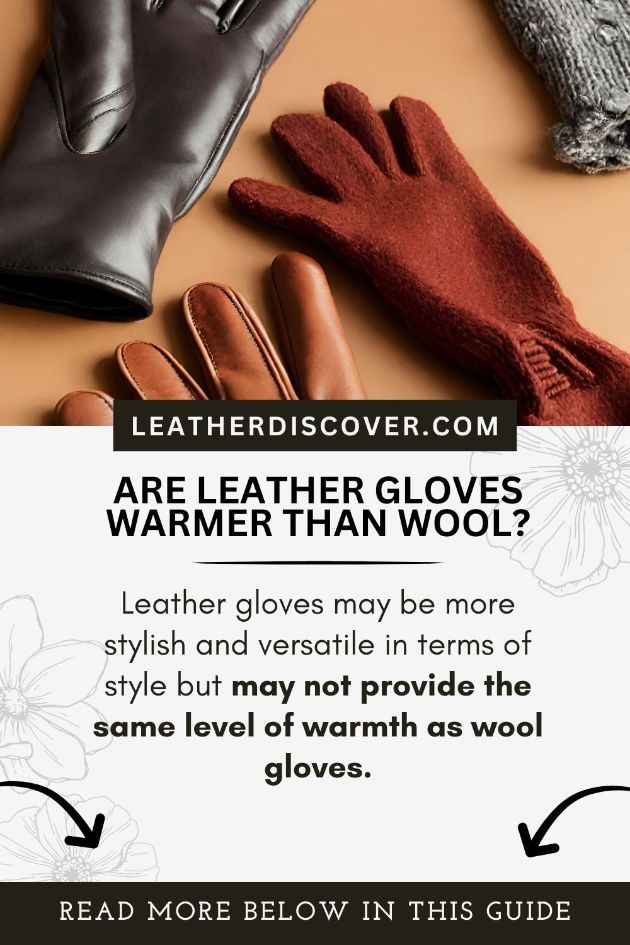
Are Leather Gloves Warmer than Wool?
Here’s a table comparing the warmth of leather gloves and wool gloves:
| Aspect | Leather Gloves | Wool Gloves |
|---|---|---|
| Insulation | Leather gloves are less insulating than wool. | Wool gloves are highly insulating. |
| Warmth | Leather gloves provide moderate warmth. | Wool gloves provide excellent warmth. |
| Material Thickness | Leather gloves are usually thicker than wool. | Wool gloves can vary in thickness. |
| Breathability | Leather gloves are less breathable. | Wool gloves are more breathable. |
| Moisture Management | Leather gloves can become cold when wet. | Wool gloves can retain warmth even when damp. |
| Wind Resistance | Leather gloves offer some wind resistance. | Wool gloves provide good wind resistance. |
| Temperature Range | Leather gloves are suitable for milder cold. | Wool gloves are ideal for colder temperatures. |
| Activities | Leather gloves are versatile for various activities. | Wool gloves are best for cold-weather activities. |
| Style | Leather gloves often have a classic, elegant look. | Wool gloves can have a casual or formal style. |
Keep in mind that specific glove types and materials may vary, so choosing the right gloves for each season depends on factors like local climate and personal preferences.
The Verdict:
While leather gloves offer moderate warmth and are suitable for milder cold conditions, wool gloves are highly insulating and excellent for colder temperatures.
Wool gloves also have better moisture management and breathability, making them a preferred choice for many cold-weather activities.
Leather gloves may be more stylish and versatile in terms of style but may not provide the same level of warmth as wool gloves.
Comparison of Leather Gloves and Wool Gloves with Different Seasons
Certainly, here’s a comparison of leather gloves and wool gloves with different seasons in mind:
| Season | Leather Gloves | Wool Gloves |
|---|---|---|
| Spring | Suitable for cool spring days, offering style and light insulation. | Not recommended for summer due to the warmth. |
| Summer | Generally not suitable due to warmth and lack of breathability. | Not recommended for summer due to warmth. |
| Fall | Ideal for early fall when temperatures start to drop. | Suitable for fall with excellent insulation properties. |
| Winter | Moderate warmth, suitable for milder winter conditions. | Excellent warmth, ideal for cold winter temperatures. |
Other Relevant Concerns You Might Have:
When deciding on leather gloves, there can be some other relevant concerns you might encounter.
What Is the Warmest Material for Gloves?
When it comes to warmth, one material stands out above the rest: down insulation.
Down gloves, typically filled with goose or duck down feathers, provide exceptional warmth by trapping pockets of air, which act as natural insulators.
These gloves are incredibly effective at keeping your hands toasty in extremely cold conditions.
Is Wool a Good Material for Winter Gloves?
Yes, wool is an excellent material for winter gloves. Wool is a natural insulator that retains heat, making it a great choice for cold weather.
Wool gloves are not only warm but also breathable, allowing your hands to stay comfortable by regulating temperature and moisture.
They are especially well-suited for moderately cold winter days.
What Is the Best Way to Choose Warm Gloves?
The best way to choose warm gloves is to consider your specific needs and the weather conditions you’ll be facing. Here are some key factors to keep in mind:
- Insulation: Look for gloves with good insulation, such as down, Thinsulate, or fleece, for superior warmth.
- Material: Wool, leather, and synthetic materials are common choices. Wool is excellent for moderate cold, while leather provides a balance of warmth and style.
- Fit: Ensure a snug but not too tight fit to trap warm air while allowing for movement.
- Water Resistance: If you’ll encounter snow or rain, opt for gloves with water-resistant or waterproof materials to keep your hands dry and warm.
- Activity: Consider your planned activities. Some gloves are designed for specific purposes, like skiing, hiking, or casual wear.
- Lining: Look for gloves with soft and warm lining materials like fleece or brushed fabric.
- Cuff Style: Choose gloves with longer cuffs to seal out cold drafts.
What Gloves Are Warmer?
Gloves with specialized insulation like down or Thinsulate tend to be warmer than gloves without such insulation.
Down gloves, in particular, are among the warmest due to their excellent insulating properties.
However, the warmth of gloves also depends on factors like material thickness, fit, and weather conditions. It’s essential to choose gloves that match your specific requirements for warmth, comfort, and intended use.
Conclusion:
So, now you know the answer to the query: Are leather gloves warmer than wool?
When it comes to staying warm in cold weather, wool gloves win the battle against leather gloves. Wool is just better at keeping your hands cozy. While leather gloves are stylish and useful in milder cold, they can’t match the exceptional warmth that wool provides.
When selecting warm gloves, remember to consider factors such as insulation, material, fit, activity, water resistance, lining, and cuff style to align with your unique needs and the weather you’ll encounter.
Ultimately, the warmth of your gloves will not only depend on the materials but also on how well they suit your specific circumstances, ensuring that your hands remain comfortably shielded from the cold.
- What Is Caiman Leather? A Detailed Guide - July 25, 2024
- What Is Tumbled Leather?A Complete Guide - July 25, 2024
- What Is Kip Leather? Premium Leather Choice - July 24, 2024

